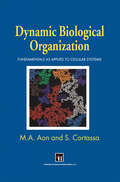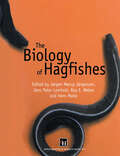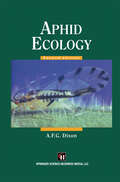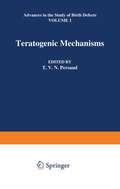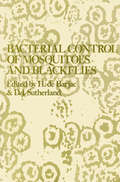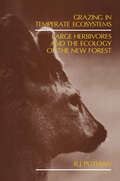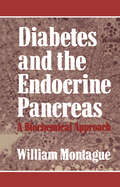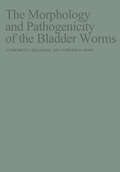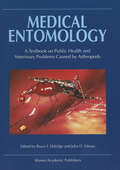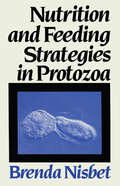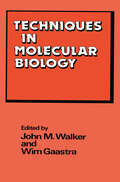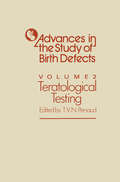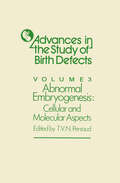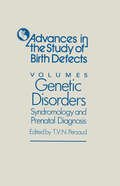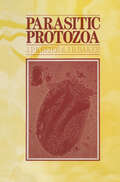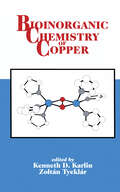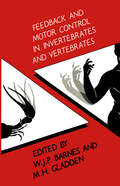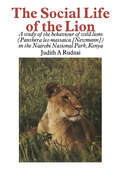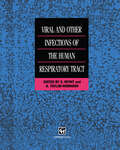- Table View
- List View
The future of DNA: Proceedings of an international If gene conference on presuppositions in science and expectations in society held at the Goetheanum, Dornach, Switzerland, 2nd – 5th October 1996
by J. Wirz E. T. Lammerts Van BuerenDynamic Biological Organization: Fundamentals as Applied to Cellular Systems
by Miguel A. Aon S. CortassaDynamic Biological Organization is a fascinating account of the living organisms as dynamic systems, based on the concept that the spatio-temporal coherence of events within a living system result from the intrinsic dynamics of the processes taking place within that sysem. The authors of this important work, Miguel Aon and Sonia Cortassa have travelled widely to work in some of the leading research laboratories to accumulate a large information base on which to assemble this book. Taking a transdisciplinary approach, the authors draw on work at the interface of biochemistry, genetics, physiology, thermodynamics, kinetics and biomathematics, using mathematical models throughout to corroborate and analyze the biological complexity presented. Emphasizing biological processes occuring at the cellular level. Dynamic Biological Organization gives exciting insights into the experimental and theoretical applications of modern scientific paradigms to fundamental biological processes.
The Biology of Hagfishes
by Jørgen Mørup Jørgensen J. P. Lomholt R. E. Weber H. MalteThe hagfishes comprise a uniform group of some 60 species inhabiting the cool or deep parts of the oceans of both hemispheres. They are considered the most primitive representatives of the group of craniate chordates, which - apart from the hagfishes that show no traces of verte brae -includes all vertebrate animals. Consequently the hagfishes have played and still playa central role in discussions concerning the evolution of the vertebrates. Although most of the focus on hagfishes may be the result of their being primitive, it should not be forgotten that, at the same time, they are specialized animals with a unique way of life that is interesting in its own right. It is now more than 30 years since a comprehensive treatise on hagfishes was published. The Biology of Myxine, edited by Alf Brodal and Ragnar Fange (Universitetsforlaget, Oslo, 1963), provided a wealth of information on the biology of hagfishes, and over the years remained a major source of information and inspiration to students of hagfishes.
Veterinary Entomology: Arthropod Ectoparasites of Veterinary Importance
by R. Wall D. ShearerAlthough usually treated as unified subject, in many respects the two components of what is broadly described as 'medical and veterinary is usual, the term entomology is entomology' are clearly distinct. As used loosely here to refer to both insects and arachnids. In medical entomology blood-feeding Diptera are of paramount importance, primarily as vectors of pathogenic disease. Most existing textbooks reflect this bias. However, in veterinary entomology ectoparasites such as the mites, fleas or dipteran agents of myiasis assume far greater prominence and the most important effects of their parasitic activity may be mechanical damage, pruritus, blood loss, myiasis, hypersensitivity and dermatitis, in addition to vector-borne pathogenic disease. Ectoparasite infestation of domestic and companion animals, therefore, has clinical consequences necessitating a distinct approach to diagnosis and control. The aim of this book is to introduce the behaviour, ecology, pathology and control of arthropod ectoparasites of domestic animals to students and practitioners of veterinary medicine, animal husbandry and applied biology. Since the book is directed primarily at the non-entomologist, some simplification of a number of the more involved entomological issues has been deemed necessary to improve the book's logical structure and comprehensibility, and keep its length within limits. A reading list is presented at the end of each chapter to act as a stepping-stone into the specialist literature.
Probiotics 2: Applications and practical aspects
by R. FullerR. Fuller 1.1 DEVELOPMENT OF COMMERCIAL PREPARATIONS The history of the probiotic effect has been well documented many times previously (see e.g. Bibel, 1982; Fuller, 1992). The consumption of fermented milks dates from pre-biblical times but the probiotic concept was born at the end of the last century with the work of Metchnikoff at the Pasteur Institute in Paris. In the century that has elapsed since Metchnikoff's work, the probiotic concept has been accepted by scientists and consumers throughout the world. Attempts to refine the practice from the use of traditional soured milks to preparations containing specific micro organisms have occupied the thoughts and endeavours of scientists in many different countries. But, in spite of the large amount of effort expended in attempting to explain and define the effect, it has to be admitted that little is known of the way in which probiotics operate. There are likely to be several different mechanisms because it seems highly improbable that a mode of action that explains resistance to microbial infection will also hold true for improved milk production or alleviation of lactose malabsorption.
Aphid Ecology An optimization approach
by A.F.G. DixonThis second edition covers the evolution of aphids and their development in relation to specific plants, thoroughly revised and expanded since the first highly successful edition. Increasing knowledge of aphids has revealed that they are ideal organisms to use when studying many topical ecological issues.
Crayfishes, Lobsters and Crabs of Europe: An Illustrated Guide to common and traded species
by R. IngleFishermen, marine aquarists, biologists studying seashore and coastal waters, and those involved in trading shellfish and even restaurateurs are aware of the great diversity of crustaceans inhabiting the seas around the British Isles, Northern Europe and the Mediterranean. Crayfishes, Lobsters and Crabs of Europe will enable the reader to identify 42 crustacean species of commercial importance found in these regions during coastal explorations, fishing trips, displayed in public aquaria or available in restaurants, including selected freshwater crayfishes, deep-sea species and some imported species. The book also includes sections on the gross internal and external structure of these Crustacea, their life histories, classification and nomenclature. The book is of interest to students of marine biology and researchers in fisheries science.
Teratogenic Mechanisms (Advances in the Study of Birth Defects #1)
by T. V. N. PersaudThe study of birth defects has assumed an importance even greater now than in the past because mortality rates attributed to congenital anomalies have declined far less than those for other causes of death, such as infectious and nutritional diseases. It is estimated that as many as 50% of all pregnancies terminate as miscarriages. In the majority of cases this is the result of faulty development. Major congenital malformations are found in at least 2% of all liveborn infants, and 22% of all stillbirths and infant deaths are associated with severe congenital anomalies. Teratological studies of an experimental nature are neither ethical nor justifiable in humans. Numerous investigations have been carried out in laboratory animals and other experimental models in order to improve our understanding of abnormal intra-uterine development. In less than two decades the field of experimental teratology has advanced phenomenally. As a result of the wide range of information that is now accumulating, it has become possible to obtain an insight into the causes, mechanisms and prevention of birth defects. However, considerable work will be needed before these problems can be resolved. This book brings together some of the more recent and important research findings related to the mechanisms and pathogenesis of abnormal develop ment. It is not only a documentation of the latest experimental work, but it also points out future directions that seem productive and challenging.
Bacterial Control of Mosquitoes & Black Flies: Biochemistry, Genetics & Applications of Bacillus thuringiensis israelensis and Bacillus sphaericus
by Huguette De Barjac Donald J. SutherlandMosquitoes and black flies are a constant threat to health and comfort, yet the modern chemical pesticides used to control them have cre ated serious ecological problems. Populations of resistant mosquitoes and black flies have evolved, beneficial insects and natural predators have been destroyed, and environmental pollution has increased worldwide. Therefore, scientists have energetically sought new, environmentally safe technologies to combat mosquitoes and black flies and the diseases they carry. Among the most effective alternative means of controlling these pests are the highly spe cific microbial agents derived from Bacillus tburingiensis or Bacillus spbaericus. The microbial control of mosquitoes and black flies is a very important, rapidly developing area of science. Entomologists and microbiologists have already achieved spectacular successes using B. tburingiensis and B. spbaericus against these pests. Recent discoveries of new bacterial isolates specific to new hosts and recent genetic improvements in these isolates have created the potential for wide-scale use of these biological control agents. Efficient microbial control of mosquitoes and black flies can now be achieved, but a proper knowledge of factors relating to the safe and effective use of these biological control agents is necessary. The efficacy of B. tburingiensis and B. spbaericus is influenced by the inherent differential tol erance of the target mosquitoes or black flies, by the formulation technology and application of these agents, and by environmental factors, especially sun light and temperature.
Grazing in Temperate Ecosystems: Large Herbivores and the Ecology of the New Forest
by R.J. PutmanThe New Forest in southern England is an area of mixed vegetation set aside as a Royal Hunting Forest in the eleventh century and since that time subjected to heavy grazing pressure from large herbivores. The entire structure of the Forest and its various communities has been developed under this continued history ofheavy grazing, with the estab lishment of a series of vegetational systems unique within the whole of Europe. The effects of large herbivores in the structuring of this eco system in the past, and the pressure of grazing continuing to this day, have in turn a profound influence, indeed the dominating influence, on the whole ecological functioning of the Forest system. Because of its assemblage of unique vegetation types, the area is clearly of tremendous ecological interest in its own right. In addition, its long history of heavy grazing ani the continued intense herbivore pressure make the New Forest an ideal study-site for evaluation of both short-term and long term effects of grazing upon temperate ecosystems. The N ew Forest (some 37,500 ha in total area) currently supports a population of approximately 2,500 wild deer (red, roe, sika and fallow); in addition 3,500 ponies and 2,000 domestic cattle are pastured on the Forest under Common Rights.
Diabetes and the Endocrine Pancreas: A Biochemical Approach (Croom Helm Biology in Medicine Series)
by W. MontagueThis book attempts to explore the contribution that biochemistry has made, thus far, to our understanding of the endocrine pancreas and its relationship to diabetes mellitus. It was written with the aim of using an important clinical problem to illustrate, to medical students, that there are many aspects of the biochemistry taught in the early years which have direct relevance to clinical medicine. Furthermore, it is hoped that such information might provide biochemistry students with a frame work on which to base further studies. To this end a selection of recent references has been placed at the end of each chapter. In spite of considerable advances in our understanding of diabetes mellitus, it is still a disease which many physicians do not seem to com prehend. This is in part related to their lack of understanding of the molecular biology of the disease. Advances in this area have been dramatic in recent years and we are now able to offer a molecular basis for a rational approach to therapy. It may be therefore that this book will provide some physicians with the information they require to help them gain a deeper understanding of the disease. I hope that everyone who reads this book is able to capture some of the fascination that the islets of Langerhans hold for myself and the many other workers actively engaged in trying to unravel their mys teries.
The Morphology and Pathogenicity of the Bladder Worms: Cysticercus cellulosae and Cysticercus bovis
by J. SlaisMedical Entomology: A Textbook on Public Health and Veterinary Problems Caused by Arthropods
by Bruce F. Eldridge John D. EdmanThe Ecology of Reproduction in Wild and Domestic Mammals
by R.M. Sadler49 about six months ... to well over a year. If there is only one part of the year that is favourable, such as spring and early summer in the temperate climates, then each species must make an evolutionary choice, so to speak, as to which parts of the reproductive cycle - conception, gestation, lactation or weanin- must be protected and which can come in less favourable times of the year. The rhesus and langur monkeys of northern India give birth during the time of year when temperatures are hottest and wells and tanks are often dry. However, gestation and the later months oflactation come during the monsoon season when food and water are abundant. In contrast the east African baboons give birth at the beginning of the small rains, and gestation and the late part of lactation occur during the six months dry season. Whether any pattern of relationship will be found to hold true for other species of primates is still not clear. It may be that a wide variety of patterns have evolved depending on the lengths of gestation and lactation and the particular ecological complex in which each species or even subspecies lives' (pages 503, 504).
The Bacterial Cell Surface
by S.M. Hammond P.A. Lambert Andrew RycroftIt is a common statement that because of its simplicity the bacterial cell makes an ideal model for the study of a wide variety of biological systems and phenomena. While no-one would dispute that much of our under standing of biological function derives from the study of the humble bacterium, the concept of a simple life-form would be hotly disputed by any scientist engaged in the determination of the relationship between structure and function within the bacterial cell. Bacteria are particularly amenable to intensive study; their physiology can be probed with powerful biochemical, genetical and immunological techniques. Each piece of information obtained inevitably raises as many questions as answers, and can lead to a highly confused picture being presented to the lay reader. Nowhere is this more evident than in the study of the surface layers of the bacterial cell. Examination of the early electron micrographs suggested that the bacterial cytoplasm was surrounded by some sort of semi-rigid layer, possessing sufficient intrinsic strength to protect the organism from osmotic lysis. The belief that the surface layers were rather passive led to their neglect, while researchers concentrated on the superficially more exciting cytoplasmic components. Over the last twenty years our view of the bacterial envelope has undergone extensive revision, revealing a structure of enormous complexity.
Nutrition and Feeding Strategies in Protozoa
by Brenda Nisbet1 Modern biologists describe protozoa as microscopic eukaryotic organ isms with a capacity for establishing themselves in almost every con ceivable habitat provided it contains moisture in some form. In 1674 at the time when Antony von Leeuwenhoek was making his first observations of 'very small animalcules' in Berkelse Mere near his home town of Delft, this concept of the ubiquity of protozoa would have been difficult to comprehend. Leeuwenhoek's curiosity later led him to examine the body fluids, gut contents and excreta of different animals and to describe 'an inconceivably great company of living animalcules, and these of divers sorts and sizes'. Here were early des criptions of parasitic protozoa, species which later came to be recog nized as Opalina, Giardia, Trichomonas and others. Following his pioneering work in the field of microscopic observation, knowledge of protozoa has accumulated at an accelerating pace. Some 30,000 living species have been identified, and an equal number of fossil species, from habitats which range from the ocean waters to the exuvial fluid of insects. The study of protozoan nutrition is a particularly interesting aspect of this expanding field of zoology. What kind of nourishment do protozoa need, how do they acqlire it, and what influence do the answers to these two questions havE on where protozoa live? The need to determine what hId of food protozoa are utilizing in their environment is desirable in al ecological studies involving micro organisms of aquatic communities.
Techniques in Molecular Biology
by J. M. Walker W. GaastraThe last few years have seen the rapid development of new methodology in the field of molecular biology. New techniques have been regularly introduced and the sensitivity of older techniques greatly improved upon. Developments in the field of genetic engineering in particular have contributed a wide range of new techniques. The purpose of this book therefore is to introduce the reader to a selection of the more advanced analytical and preparative techniques which the editors consider to be frequently used by research workers in the field of molecular biology. In choosing techniques for this book we have obviously had to be selective, and for the sake of brevity a knowledge of certain basic biochemical techniques and terminology has been assumed. However, since many areas of molecular biology are developing at a formidable rate and constantly generating new terminology, a glossary of terms has been included. The techniques chosen for this book are essentially based on those used in a series of workshops on 'techniques in molecular biology' that have been held at The Hatfield Polytechnic in recent years. In choosing these chapters we have taken into account many useful suggestions and observations made by participants at these workshops. Each chapter aims to describe both the theory and relevant practical details for a given technique, and to identify both the potential and limitations of the technique. Each chapter is written by authors who regularly use the technique in their own laboratories.
Teratological Testing (Advances in the Study of Birth Defects #2)
by T. V. N. PersaudThe study of birth defects has assumed an importance even greater now than in the past because mortality rates attributed to congenital anomalies have declined far less than those for other causes of death, such as infectious and nutritional diseases. It is estimated that as many as 50% of all pregnancies terminate as miscarriages. In the majority of cases this is the result of faulty development. Major congenital malformations are found in at least 2% of all liveborn infants, and 22% of all stillbirths and infant deaths are associated with severe congenital anomalies. Teratological studies of an experimental nature are neither ethical nor justifiable in humans. Numerous investigations have been carried out in laboratory animals and other experimental models in order to improve our understanding of abnormal intra-uterine development. In less than two decades the field of experimental teratology has advanced phenomenally. As a result of the wide range of information that is now accumulating, it has become possible to obtain an insight into the causes, mec.;hanisms and prevention of birth defects. However, considerable work will be needed before these problems can be resolved. The· contributions in this volume deal primarily with the areas of terato logical evaluation and the use of selected animal models for the study of con genital anomalies. It is not only a documentation of the latest experimental work, but it also indicates new and important areas for future research.
Abnormal Embryogenesis: Cellular and Molecular Aspects (Advances in the Study of Birth Defects #3)
by T. V. N. PersaudThe study of birth defects has assumed an importance even greater now than in the past because mortality rates attributed to congenital anomalies have declined far less than those for other causes of death, such as infectious and nutritional diseases. It is estimated that as many as 50% of all pregnancies terminate as miscarriages. In the majority of cases this is the result of faulty development. Major congenital malformations are found in at least 2% of all liveborn infants, and 22% of all stillbirths and infant deaths are associated with severe congenital anomalies. Teratological studies of an experimental nature are neither ethical nor justifiable in humans. Numerous investigations have been carried out in laboratory animals and other experimental models in order to improve our understanding of abnormal intrauterine development. In less than two decades the field of experimental teratology has advanced phenomenally. As a result of the wide range of information that is now accumulating, it has become possible to obtain an insight into the causes, mechanisms, and prevention of birth defects. However, considerable work will be needed before these problems can be resolved. The comributions in this volume include some of the more recent and exciting observations on the cellular and molecular aspects of developmental defects. It is not only a documentation of the latest experimental work, but it also indicates new and important areas for future research.
Genetic Disorders, Syndromology and Prenatal Diagnosis (Advances in the Study of Birth Defects #5)
by T. V. N. PersaudBirth defects have assumed an importance even greater now than in the past because infant mortality rates attributed to congenital anomalies have declined far less than those for other causes of death, such as infectious and nutritional diseases. As many as 50 % of all pregnancies terminate as miscarriages, and in the majority of cases this is the result of faulty intrauterine development. Major congenital malformations are present in at least 2 % of all liveborn infants, and 22 % of all stillbirths and infant deaths are associated with severe congenital anomalies. Not surprisingly, there has been a great proliferation of research into the problems of developmental abnormalities over the past few decades. This series, Advances in the Study of Birth Defects, was conceived in order to provide a comprehensive focal source of up-to-date information for physi cians concerned with the health of the unborn child and for research workers in the fields of fetal medicine and birth defects. The first four volumes featured recent experimental work on selected areas of high priority and intensive investigation, including mechanisms of teratogenesis, teratological evaluation, molecular and cellular aspects of abnormal development, and neural and behavioural teratology. It seems logical and timely that the clinical aspects should now be presented. Accordingly, leading experts were invited to review a broad range of common problems from the standpoint of embryology, aetiology, clinical manifestations, diagnosis and management. This volume deals with genetic disorders and prenatal diagnosis.
Parasitic Protozoa
by J.P. Kreier J.R. BakerIt is now 17 years since the junior author's book Parasitic protozoa was first published, and 13 years since it received limited revision. The study of symbiotic protozoa has meanwhile progressed, and much of the content of the earlier book has been superseded if not displaced by recent knowledge. We believe that there is still a place for an introductory textbook, conventionally arranged on a taxonomic frame work, on this most fascinating group of organisms. It should supplement (certainly not supplant) more modern treatments from different angles. A mountain looks very different if one approaches it from different sides, though a true picture of that mountain can be built up only by the laborious summation of the views provided by all approaches. The immunology and the chemotherapy of protozoal infections are subjects so complex that we do not propose to try to encompass them in this book. We mention briefly the more commonly used therapeutic compounds in the various chapters that follow, without giving details of dosage schedules. Further information on immunology and chemo therapy can be obtained from the books listed at the end of the Introduction; the information we give on chemotherapy is largely drawn from that of James & Gilles. This book can be regarded as an evolutionary descendant of the earlier "Parasitic protozoa", referred to above, extensively revised and much more fully illustrated. We hope that it will prove as useful as its predecessor appears to have been.
Bioinorganic Chemistry of Copper
by K.D. Karlin Z. TyeklarBioinorganic Chemistry of Copper focuses on the vital role of copper ions in biology, especially as an essential metalloenzyme cofactor. The book is highly interdisciplinary in its approach--the outstanding list of contributors includes coordination chemists, biochemists, biophysicists, and molecular biologists. Chapters are grouped into major areas of research interest in inorganic copper chemistry, spectroscopy, oxygen chemistry, biochemistry, and molecular biology. The book also discusses basic research of great potential importance to pharmaceutical scientists. This book is based on the first Johns Hopkins University Copper Symposium, held in August 1992. Researchers in chemistry, biochemistry, molecular biology, and medicinal chemistry will find it to be an essential reference on its subject.
Feedback and Motor Control in Invertebrates and Vertebrates
by W. P. BarnesThis book is a collection of papers given by invited speakers at a Symposium on 'Feedback and Motor Control', held at the University of Glasgow from July 10th to 13th 1984, which was attended by over 200 scientists from 20 countries. The Symposium was the Fourth International Symposium organised by the Scottish Electrophysiological Society (SES), and on this occasion the SES joined forces with the Society for Experimental Biology (SEB), so that the Symposium was held dur ing the annual Summer Meeting of the SEB. A policy of the SES since its formation in 1970 has been to promote dialogue between scientists working on invertebrate and vertebrate nervous systems by hol
The Social Life of the Lion: A study of the behaviour of wild lions (Panthera leo massaica [Newmann]) in the Nairobi National Park, Kenya
by J.A. RudnaiTHE HABITAT Nairobi National Park lies to the south-southeast of the capital of Kenya, Nairobi, where the Athi Plains meet the Eastern escarpment of the Rift Valley. These plains form part of the semi-arid highland plateau lying between the coast and the Rift Valley. Both the city itself, and the Park bordering it, are a meeting place of two generally distinct types of landscape and climate. While to the east-southeast are semi-arid plains with grasslands and scattered trees, the western-north western parts are higher, hilly, cooler, more humid and support lush forests. The combination of latitude-a little over one degree south of the Equator -and altitude-average of 1600 m. (5000-5500 ft.) -combine to give Nairobi a most equable climate where the temperature varies during the year between about 11 degrees and 27 degrees centigrade (mean minimum and mean maximum for eight years). However, considerable changes are usually experienced within each day and a rise from 14 degrees C at 0600 hours to 22 degrees at 1100 hours is not unusual. Nairobi Park has a unique concentration of wild animals living in their natural habitat less than 10 km. from the centre of a modern city of half a million people. The only interference with the natural course of events in the Park is that normally required for the proper management of a game park, such as maintenance of roads and dams, and, in this particular case, partial fencing towards the city.
Viral and Other Infections of the Human Respiratory Tract
by DavidTaylor-Robinson StevenMyintThis book is a festschrift to mark the career of ogy, immunology and clinical aspects of each Dr David Tyrrell, eminent virologist and group. There are also more general chapters physician. Almost all of the contributors have overviewing the clinical manifestations, treat been colleagues or students at some time ment and pathophysiology of respiratory during his career. Unlike most festschrifts, virus infections. In addition, chapters in however, the essays have been integrated to which psychological aspects and the ethical produce a comprehensive book that covers use of human volunteers are discussed will be the entire field of non-bacterial infections of of interest to all those involved with respira the human respiratory tract. This is a measure tory infectious agents. of the breadth of interest of the research We hope also that this book serves as a undertaken by David, spanning a period of fitting tribute to a man who is a true poly over 40 years. math: a physician, researcher, teacher, We hope that this book will be of interest mentor, linguist and ambassador for science, to microbiologists, virologists and in particu among other things. To those of us who have lar, to physicians. All the major virus groups contributed to this book, he is even more: a are covered, as well as chlamydial and friend.

